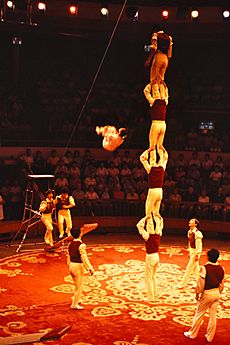Acrobatics facts for kids

Acrobatics is all about amazing human feats of balance, agility, and motor coordination. Think about people doing incredible flips, twists, and holds! The word "acrobatics" comes from an Ancient Greek word meaning "to walk on tiptoe" or "to strut."
You can see acrobatics in many places. It's a big part of performing arts like the circus and acro dance. It's also key in many sports like gymnastics, ballet, and diving. While we usually think of people, the term "acrobatics" can also describe things like aerobatics, which are amazing airplane stunts.
Contents
History of Acrobatics
Acrobatics has a very long and interesting history. People have been performing acrobatic feats for thousands of years in many different cultures around the world.
Ancient Times
Both the Ancient Greeks and Romans practiced acrobatics. In Europe during the Middle Ages, acrobatic shows were often part of displays at noble courts. These performances sometimes included juggling as well.
Acrobatics in China
In China, acrobatics has been an important part of the culture for a very long time. It dates back to the Western Han Dynasty (206 BC-AD 220). Acrobatic acts were often seen at village harvest festivals.
During the Tang Dynasty (7th to 10th century), acrobatics became very popular in court shows, much like in Europe. Today, acrobatics is still a very important part of modern Chinese variety art.
Modern Acrobatics
The word "acrobatics" first meant only tightrope walking. But by the 19th century, it started to include all sorts of performance art, especially circus acts.
Later in the 19th century, activities like tumbling and other acrobatic and gymnastic moves became competitive sports in Europe. This led to the development of many of the gymnastic sports we know today.
Related pages
Images for kids
-
A contortionist performing with Cirque du Soleil
-
A high wire act
See also
 In Spanish: Acrobacia para niños
In Spanish: Acrobacia para niños









